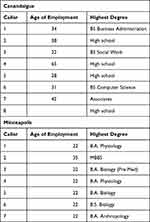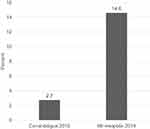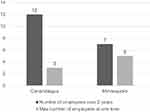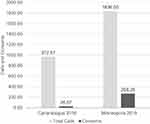Back to Journals » Open Access Journal of Clinical Trials » Volume 13
Impacts of Research Staff Burnout for a National Large Scale Pragmatic Clinical Trial
Authors Majkut Klint A, McPherson J , Tella A, Vang W , Raju S , Windschitl R , Ishani A
Received 26 March 2021
Accepted for publication 11 June 2021
Published 5 July 2021 Volume 2021:13 Pages 31—35
DOI https://doi.org/10.2147/OAJCT.S312365
Checked for plagiarism Yes
Review by Single anonymous peer review
Peer reviewer comments 2
Editor who approved publication: Professor Arthur E. Frankel
Alison Majkut Klint,1 Jacob McPherson,2 Abhinav Tella,2 William Vang,2 Srihari Raju,2 Rebecca Windschitl,2 Areef Ishani3
1Boston CSPCC, VA Boston Healthcare System, Jamaica Plain, MA, USA; 2Research, Minneapolis VAHCS, Minneapolis, MN, USA; 3Primary Care and Specialty Care Integrated Care Community (ICC), Minneapolis VAHCS, Minneapolis, MN, USA
Correspondence: Alison Majkut Klint
VA Boston Healthcare System, 150 S Huntington Ave, Jamaica Plain, MA, 02130, USA
Tel +1 857-364-4885
Email [email protected]
Introduction: Burnout can have a negative impact on job satisfaction and productivity. Antecedents to burnout include workload, control, values, fairness, reward, community and job-person incongruency.
Purpose: To better understand the impact of burnout in research staff, these seven antecedents to burnout were analyzed retrospectively within the call centers for the Diuretic Comparison Project.
Methods: Two call centers were analyzed with respect to these antecedents to burnout. Consent rates and employee turnover of the two call centers were compared as a means of comparing productivity and job satisfaction, respectively.
Results: An odds ratio of 0.13 (95% CI=[0.0164, 1.0853]) indicates that an employee at the Minneapolis call center had lower odds of leaving than an employee at the Canandaigua call center. The call center in Canandaigua had a consent rate of 2.7% (Figure 2). The consent rate for the same months of the following year in Minneapolis came out to 14.6%.
Conclusion: A higher consent rate and lower turnover rate of the call center in Minneapolis could be a result of lower levels of burnout among callers. The confidence interval of the odds ratio calculated for turnover indicates that the result is not statistically significant. Due to the retrospective nature of the analysis, extraneous variables were not controlled for analyzing this data. The protocol of the Minneapolis call center appears to take into consideration the antecedents to burnout more than that of the Canandaigua call center. Further studies on burnout prevention methods for clinical research are needed. Research staff could benefit from strategies to help reduce burnout. Organizations should provide proper protocols and training concerning stress and burnout to improve the well-being of employees and, in turn, their productivity.
Clinical Trial Registration: : CSP597 or clinicaltrials.gov NCT02185417.
Keywords: researcher burnout, clinical trial, call center
Introduction
Burnout was defined in 1974 by Freudenberger as increasing anger, frustration, suspicion and paranoia regarding colleagues’ influences on one’s own personal career ambitions, excessive rigidity and inflexibility in practice, and the appearance of characteristics of one who suffers from depression1 There are three dimensions of burnout. The first is emotional exhaustion, which includes both emotional stress and physical exhaustion. Emotional exhaustion can cause a person to feel disinterested in their work. These feelings can lead to the second dimension of burnout, which is depersonalization or cynicism. A person experiencing this aspect of burnout may feel detached from or have a negative attitude regarding their work. The third dimension is a decreased sense of personal accomplishment.2 Someone experiencing this lack of personal accomplishment may feel that their efforts are never enough. This may create a feeling of hatred related to their work.1 There are seven antecedents which, when at an imbalance, are related to the development of burnout. These antecedents are workload, control, values, fairness, reward, community and job-person incongruency.3
Burnout shares some symptoms with depression. A survey of physicians found that those who suffered burnout symptoms were more likely to experience major depression and that physicians with depression were more likely to experience burnout symptoms.1 Burnout is related to cardiovascular diseases, musculoskeletal pain, depressive symptoms, psychotropic or antidepressant treatment, and job dissatisfaction. These impacts on a person’s health and well-being can lead to a loss of productivity. They may also be absent from work entirely, reducing the organization’s productivity.4
High burnout of healthcare professionals is correlated with poor patient safety outcomes and increased medical errors.1 Although burnout is more well-studied in other healthcare professions, clinical research coordinators (CRCs) are also affected by burnout. Study quality, efficiency, patient safety and staff wellbeing can all be negatively impacted by burnout. CRCs report similar levels of burnout when compared with other healthcare workers.5
The effects of burnout on research staff were analyzed for the Diuretic Comparison Project (DCP), a large-scale clinical trial sponsored by the VA. Burnout is commonly measured using a survey known as the Maslach Burnout Inventory (MBI).6 However, this analysis is retrospective and survey data is not available, so this paper will be using existing workplace data available in an attempt to determine differences in levels of burnout. Consent for participation in the DCP is obtained over the phone by dedicated call staff. Differences between two call centers were evaluated to better understand how to reduce burnout of research staff in a study of this nature. Within the DCP, the workload of research assistants is often characterized by the enrollment of study participants. Potential burnout related to participant recruitment is prevalent. Research staff may lack control of work hours, their role within the study, and organizational decisions. They may also feel that they lack control over whether patients will answer their calls and will consent to participate in the study. This lack of control could increase a researcher’s risk of burnout.3 Risk of burnout is also higher when a person’s values do not parallel those of the organization.7 Callers may feel a sense of responsibility for patients’ well-being and a desire to speak with them about more than the study protocol or call script. Occasionally this desire may not align with the protocol. This incongruence can cause a caller to feel pressured to go against personal values in order to follow protocol, or they may feel the need to go against protocol to do what feels right. A sense of fairness within an organization and from supervisors, adequate recognition or reward, and a sense of community at work all play a role in reducing the risk of burnout. Researchers experience similar levels of personal accomplishment burnout compared to other healthcare professionals. One factor correlated with personal accomplishment burnout is job satisfaction.5 Two other factors that may contribute to personal accomplishment burnout within the DCP could be the number of patients in the workflow and the delay of approval. Regardless of the number of patients called or enrolled there will always be more patients waiting in the workflow. The delay in approval for the study may cause researchers to question whether it is worth the time and effort needed.
Methods
The Diuretic Comparison Project had two call centers that contacted patients to ask for their consent to enroll them in the clinical trial. The first call center was set up in Canandaigua, NY. The call center in Minneapolis, MN was established in 2018 to replace the Canandaigua call center. The Canandaigua call center hired employees on a full-time basis at a GS5 level salary. The call center specifically focused on hiring callers with customer service experience. The Canandaigua call center also specialized as the Veterans Crisis Hotline and was part of the Million Veterans Program, though the callers for this project never worked on those programs. The call center had a local manager and supervisor. Neither were study or research oriented. The office environment was organized into small, personalized calling “booths”.
The Minneapolis call center hired GS7 level employees. GS7 employees must have a bachelor’s degree, whereas GS5 employees are only required to have some college or specialized experience. GS7 employees have a salary that is approximately 9000 dollars higher than that of a GS5 employee. The Minneapolis call center made hiring decisions with a preference for employees with a master’s degree and a background in science with intentions of pursuing higher education. The difference in educational background is shown in Table 2. This call center was research oriented and worked only on this project. The local supervisor for the Minneapolis callers was the national study coordinator, who reports directly to the study’s principal investigator. The office setting had private offices with doors.
 |
Table 2 Additional Demographic Information Available for Employees of Each Call Center |
The bulk of the workload at the call centers was the number of calls to make each day. The expectation was that callers would make 100 calls each day. In Minneapolis, this goal was not pushed on callers. Callers in Minneapolis were also given other study-related tasks, such as helping with research papers.
Performance and burnout have been found to be related.8,9 Patient consent rates were used as a measure of performance for the two call centers. Burnout can be predictive of employee turnover.10 Employee turnover and patient consent rates were compared between the two call centers in an attempt to compare levels of caller burnout. Consent rate data for Canandaigua was taken from 2018 and data for Minneapolis was taken from 2019. Both sets of data were taken from February through April. To compare turnover rates an odds ratio was calculated. The number of employees who left their jobs was used as the positive outcome, the numerator, and the number of employees that remained employed was used as the negative outcome, the denominator, in calculating the odds of an employee leaving for each call center. The odds of an employee leaving Minneapolis was divided by the odds of an employee leaving Canandaigua to get the odds ratio.
Results
Figure 1 compares the number of calls and consents per employee from Canandaigua to those from Minneapolis. The call center in Canandaigua had a consent rate of 2.7% (Figure 2). The consent rate for the same months of the following year in Minneapolis came out to 14.6%. Canandaigua had a total of 12 employees over a period of two years and had no more than 3 at any one time while Minneapolis had a total of 7 employees with a maximum of 5 at one time (Figure 3). Table 1 was used to determine an odds ratio. The odds ratio comparing the turnover of the call centers was 0.13 (95% CI=[0.0164, 1.0853]).
 |
Figure 2 Consent rates of the call centers in Canandaigua and Minneapolis from the same months one year apart. Rates were calculated from the total number of calls made, including multiple calls to the same patient, and the number of consents received shown in.Figure 1 |
 |
Figure 3 A comparison of the number of employees over two years and the maximum number of employees at any one time at the call centers in Canandaigua and Minneapolis. |
Conclusion
The reduced personal accomplishment dimension of burnout is related to reduced productivity.4 Increased productivity may have resulted in improved consent rates. Burnout has also been found to increase turnover rates.11 Therefore, a higher consent rate and lower turnover rate of the call center in Minneapolis could be viewed as greater productivity and job satisfaction, both of which could be a result of lower levels of burnout among callers. Reduced pressure to make a certain number of calls, a greater variety of responsibilities, being involved in project decisions, meetings for discussions between callers, equal distribution of responsibilities and hiring employees who intend to pursue higher education could have all contributed to reduced levels of burnout at Minneapolis compared to Canandaigua. The small sample size in the turnover calculation creates a high margin of error. The odds of 0.13 would indicate that Minneapolis callers had lower odds of departing their position compared to Canandaigua callers. However, the confidence interval includes 1.00, which indicates the odds ratio results are not statistically significant. Analysis of the consent rate data does not control for extraneous variables such as the difference in average age when employed seen in Table 2. Neither of these results should be considered as evidence of reduced burnout as a direct result of differences between the call centers, but instead suggest that burnout levels may have been reduced. The possible reduction in burnout found in this retrospective analysis along with data from other literature on burnout, indicate a need for further studies on burnout prevention methods in clinical research.
Developing methods for preventing burnout in research studies could help to improve the wellbeing of researchers and the productivity of the organization. Organizations should address any stigma surrounding mental health needs. Burnout can have negative impacts on an individual’s mental and physical wellbeing. In the 1970s, Freudenberger shared ideas of how to help reduce burnout. His ideas included guarding against rapid turnover in the hiring process, avoiding task redundancy, limiting professional work hours, and allowing employees to share and reflect on their collective experiences.1 When an organization creates a culture that helps employees deal with stress and provides proper education and training concerning stress and burnout, the wellbeing of employees, and in turn their productivity, can be improved.12
Ethics
The Diuretic Comparison Project was approved by the VA Central Institutional Review Board and conducted in accordance with the Declaration of Helsinki.
Disclosure
The authors declare that there is no conflict of interest. The contents do not represent the views of the US Department of Veterans Affairs or the United States Government. This research received no specific grant from any funding agency in the public, commercial, or not-for-profit sectors.
References
1. Bridgeman PJ, Bridgeman MB, Barone J. Burnout syndrome among healthcare professionals. Am J HealthSystem Pharm. 2018;75(3):147–152. doi:10.2146/ajhp170460
2. Lee RT, Ashforth BE. On the meaning of Maslach’s three dimensions of burnout. J Appl Psychol. 1990;75(6):743–747. doi:10.1037/0021-9010.75.6.743
3. Leiter MP. Key worklife areas contributing to health care burnout: reflections on the ORCAB project. Br J Health Psychol. 2015;20:223–227. doi:10.1111/bjhp.12124
4. Salvagioni DAJ, Melanda FN, Mesas AE, et al. Physical, psychological, and occupational consequences of job burnout: a systematic review of prospective studies. PLoS One. 2017;12(10):1–29. doi:10.1371/journal.pone.0185781
5. Gwede CK, Johnson DJ, Roberts C, et al. Burnout in Clinical Research Coordinators in the United States. Oncol Nurs Forum. 2005;23(6):1123–1130. doi:10.1188/05.ONF.1123-1130
6. Maslach C, Jackson SE. The measurement of experienced burnout. J Occupational Behav. 1981;2:99–113. doi:10.1002/job.4030020205
7. Veage S, Ciarrochi J, Deane F, et al. Value congruence, importance and success and in the workplace: links with well-being and burnout amongst mental health practitioners. J Contextual Behav Sci. 2014;3(4):258–264. doi:10.1016/j.jcbs.2014.06.004
8. Keijsers GJ, Schaufeli WB, Le Blanc PM, et al. Performance and burnout in intensive care units. Work Stress. 1995;9(4):513–527. doi:10.1080/02678379508256897
9. Prentice C, Thaichon P. Revisiting the job performance – burnout relationship. J Hospitality Marketing Manage. 2019;28(7):807–832. doi:10.1080/19368623.2019.1568340
10. Leiter MP, Maslach C. Nurse turnover: the mediating role of burnout. J Nurs Manag. 2009;17(3):331–339. doi:10.1111/j.1365-2834.2009.01004.x
11. Wilson F. Identifying preventing, and addressing job burnout and vicarious burnout for social work professionals. J Evid Informed Soc Work. 2016;13(5):479–483. doi:10.1080/23761407.2016.1166856
12. Bakhamis L, Paul DP
 © 2021 The Author(s). This work is published and licensed by Dove Medical Press Limited. The full terms of this license are available at https://www.dovepress.com/terms.php and incorporate the Creative Commons Attribution - Non Commercial (unported, v3.0) License.
By accessing the work you hereby accept the Terms. Non-commercial uses of the work are permitted without any further permission from Dove Medical Press Limited, provided the work is properly attributed. For permission for commercial use of this work, please see paragraphs 4.2 and 5 of our Terms.
© 2021 The Author(s). This work is published and licensed by Dove Medical Press Limited. The full terms of this license are available at https://www.dovepress.com/terms.php and incorporate the Creative Commons Attribution - Non Commercial (unported, v3.0) License.
By accessing the work you hereby accept the Terms. Non-commercial uses of the work are permitted without any further permission from Dove Medical Press Limited, provided the work is properly attributed. For permission for commercial use of this work, please see paragraphs 4.2 and 5 of our Terms.


